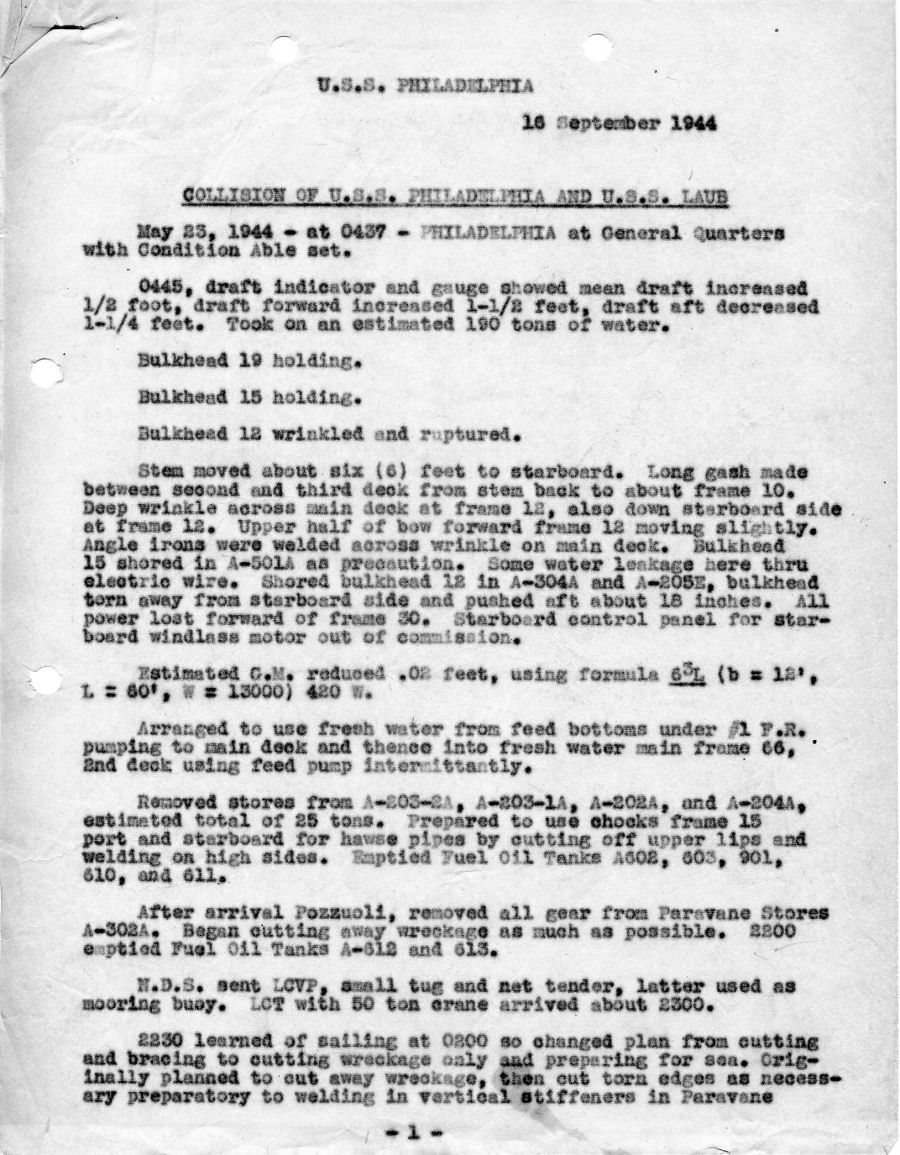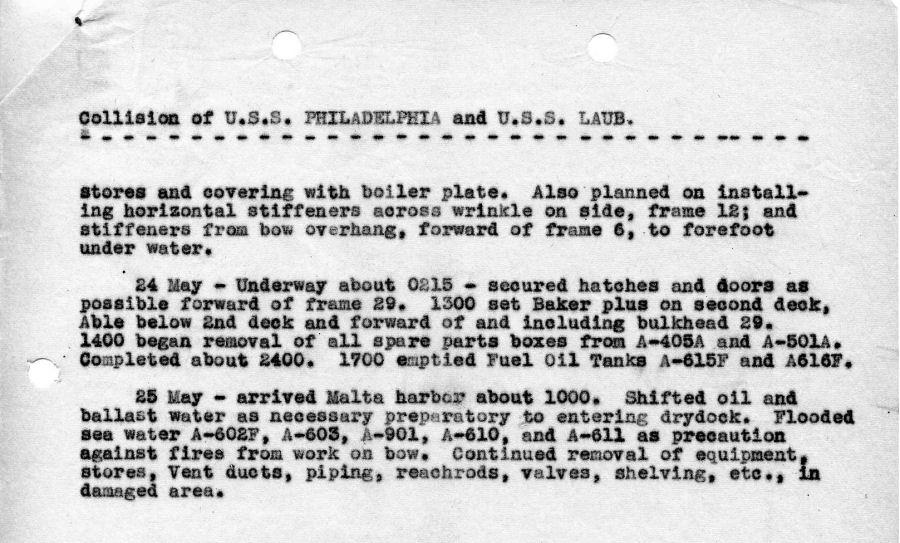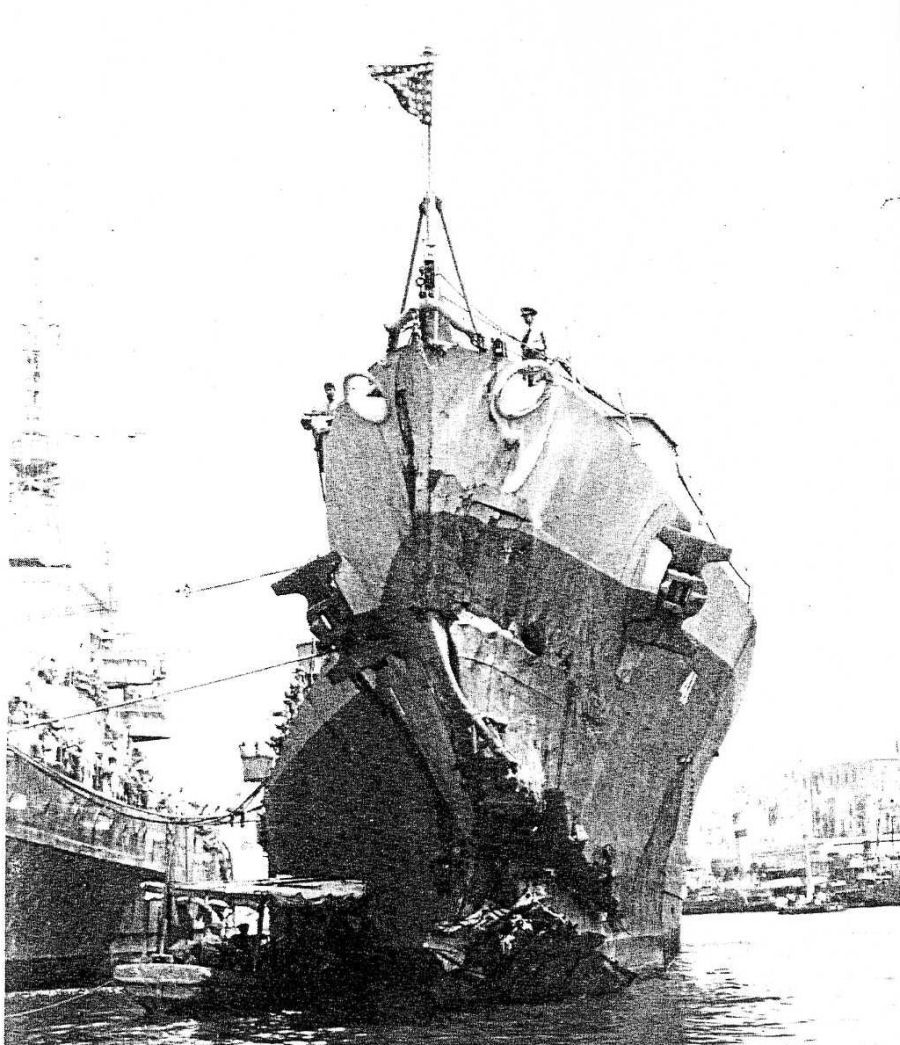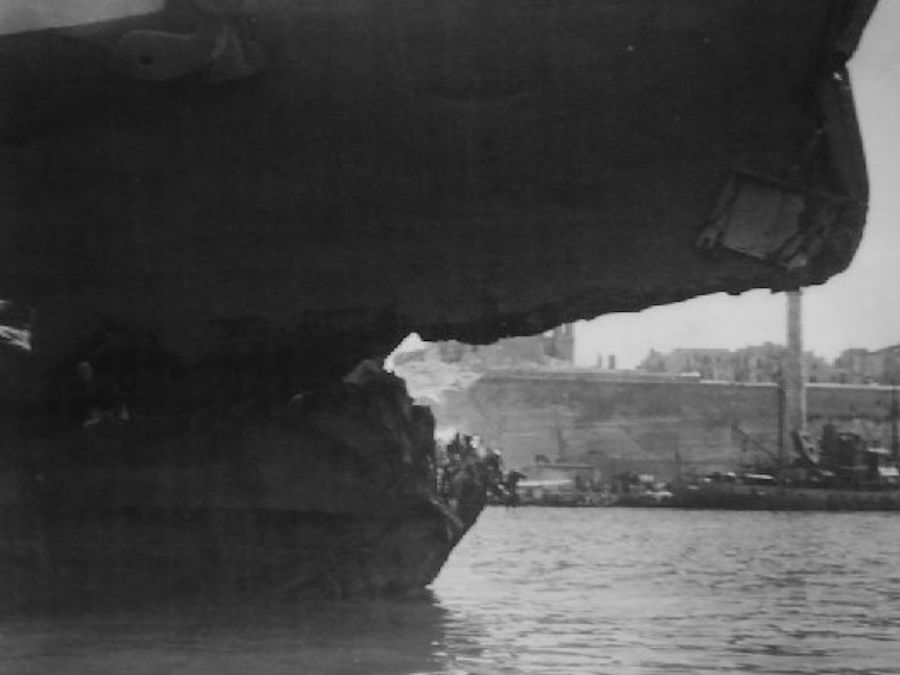Summary of Incident
by Bob Stark
USS
Philadelphia was steaming in company with USS Kendrick and USS
Laub en route to the fire support area at Anzio. It was the morning watch on May 23, 1944. Kendrick was stationed to starboard and Laub
to port. Each was at 3,000
yards, 40 degrees on either bow. Visibility
was reduced by darkness, weather and sea conditions.
The ships were on base course 335
degrees true, at a speed of 20 knots. At
0427 Laub was ordered to take station astern of Philadelphia. At 0433 a signal was made to stand by to change
base course to 037 degrees true, to follow the swept channel
into Anzio and change
speed to 15 knots. At
0434 this signal was executed. All
of these signals were by TBS and in code.
At
the instant the signal to execute the change in base course was
received, Philadelphia, sighted Laub about
1,000 yards away apparently headed across Philadelphia’s
bow. Orders were given
on Philadelphia for
left full rudder and all engines back full
. Philadelphia struck
Laub on the starboard side abreast the after stack and caused
flooding of the after fire room and after engine room. Laub
lost all power and was unable to operate either engine. Laub lost two men and had four others injured. Philadelphia’s bow was crushed forward of frame 12
and suffered no casualties to personnel. Laub began to
jettison depth charges, torpedoes and ammunition in order to
maintain stability and restored electric power shortly after
the collision. Kendrick was ordered to stand by Laub. Philadelphia restored
watertight integrity forward of frame 19 and eventually proceeded
to Malta for
repairs. Laub was later
towed to Naples for repairs.
Collision as seen from Philadelphia
Philadelphia was
in Condition Able and at general quarters with Captain Ansel
on the bridge. Lieutenant
Caton was OOD and Lieutenant (jg) Erickson was Junior OOD. Ship
was steaming at 20 knots on course 335 true. Kendrick was 40 degrees on the starboard bow
distant 3,000 yards. Laub
was similarly located on the port bow. Visibility
was reduced by darkness, haze and sea conditions. Wind
speed was about 20 knots from west-northwest. The sea was heavy with intermittent spray coming
over the port bow. Both
surface search radars were tracking three distant targets and
could not follow movements of the screen as a result of ground
clutter within 2500 yards. At 0427 Laub was ordered by TBS to take station
astern. This order was
acknowledged. At 0433 a coded TBS message was sent to the
screen to stand by to change base course to 037 true with Kendrick
in the lead and Laub astern of Philadelphia. Both ships acknowledged this message. The order to execute the course change was
given at 0434. Immediately
after the execute was given, Captain Ansel sighted Laub about
500 to 1000 yards to port and remarked, “That fellow looks as
though he is going to cross our bow”. At that instant the OOD asked “Shall we come
right?” The Captain replied, “Yes,
come right.” He then saw
that Laub was on a collision course and ordered “Hard left rudder, All engines
stop, All engines back full and all engines back emergency full” in
quick succession.
When the Captain ordered “yes, come right.” The OOD ordered “right full rudder.” The helmsman had time to get about six degrees
of right rudder on when the
order was changed to “left hard rudder. After this command was given, the OOD passed
the word on the announcing system, ”Stand
by collision portside forward” and sounded the siren. The
rudder was over hard left when the ships collided and all four
engines were backing down at the time of impact. Philadelphia’s
heading at the time of impact was about 310 true. The two ships parted soon after impact as a
result of Philadelphia’s
backing. At the time Laub
was sighted she was about 800 yards distant with a relative bearing
of 330 degrees and a target angle of about 50 degrees.
Damage
to Philadelphia consisted
of a cut in the bow for about 30 feet caused by impact with the
main deck of Laub. The
main deck was twisted to port and the ship was
watertight forward of frame 12. The
next bulkhead aft was strengthened.
Collision as seen from Laub
Laub
screening on port bow of Philadelphia as
described above. Commanding
Officer, Commander Roessler, was not on bridge at time of collision. Lieutenant Hunley was OOD and Ensign Lucas
JOOD. When ship received
directive to take station astern of Philadelphia,
OOD requested a maneuvering board solution from CIC for course
and speed to take position 2000 yards astern of Philadelphia. CIC responded with recommendation of course
105 true and speed 23 knots. An
order was given to the helmsman “right standard rudder”. No course was given and the helmsman was calling
off headings at 20 degree intervals. When
he reached 20 true he was told to steady on this heading. Shortly thereafter, Philadelphia was
sighted and orders were given for left full rudder and all engines
full speed astern. The
bow of Philadelphia pierced
shell plating of Laub from frames 123 to 147. The after fire room and engine room were both
flooded and the starboard shaft damaged. All
electric power was lost. The
ship took a 9 degree list to starboard. At
0445 ship commenced jettisoning all non-essential topside gear. All torpedoes, all accessible depth charges,
some 5”/38 ammunition from both forward and aft, and quantities
of 40mm and 20mm ammunition were jettisoned. Electric
power was restored at about 0520. At 0530 crew was mustered on station and it
was determined that two men had been killed and four men wounded. At 0715 the ship was taken in tow by USS Symbol
(M223) and proceeded to Naples at
six knots. At 0730, the
list to starboard had been decreased to 5 degrees.
Final Notes
A
Court of Inquiry was established and met on Philadelphia in Malta and
later flew to Naples to
visit Laub. The findings
of the Court were never seen by the author of this note, but
Captain Ansel and Lieutenant Caton were exonerated of all blame. It
is believed several of the officers in Laub were disciplined
in some form. In retrospect, the most serious error committed
that morning was the request by the OOD for a maneuvering board
solution for a course and speed to take station astern of Philadelphia.
Laub would have been much better
served by slowing until abreast of Philadelphia and then moving
slowly astern or by making a slow 360 degree turn to port and
falling into position in that way. Philadelphia spent
several months enjoying Malta and
later took part in the landings in Southern France. Since the collision took place on May 23 and
D-day at Normandy was
June 6, it is doubtful we would have been required to participate
in that operation. I suspect the army would have continued to
request assistance at Anzio for
quite some time if we had stayed fit.
|





